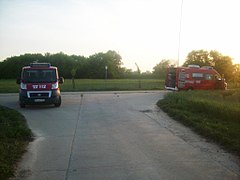Radio vehicles
The radio cars (partly also (FuKW) radio squad vehicles ( FuTrKW called)) is a vehicle type of the disaster and civil defense .
Current use in Saxony-Anhalt
General information about the vehicle type

The radio troop vehicle is used today in Saxony-Anhalt as a guide for large-scale operations, large events and in the event of a disaster. It serves as an operations control center for the operations manager, from whom he can direct the operation by radio. The vehicle can also be operated as a relay station to improve radio coverage in a specific area. The additional antenna has a stronger transmit and receive power than the standard vehicle antenna even in retracted mode.
The radio troop vehicle is part of the management support service. The management support specialist service is to be set up by every district and city. Precise instructions on how and by what means and vehicles are not regulated in more detail.
Depending on the district or city, the radio troop vehicle is either stationed at a location of the respective regional authority at the district level, for example in the fire service center , or directly at a fire service. In the case of stationing with a fire brigade, this also provides the crew for the vehicle. It looks different when stationed in the district. Here the crew is made up of emergency services from the fire departments of the district.
Most newer vehicles are divided into two compartments. The front compartment consists of the driver's cab for the driver and front passenger as well as the two radio workstations. The driver and front passenger seats can be rotated 180 degrees to operate the two wireless workstations. The conference room with five seats is located in the rear compartment. Both compartments are connected by a small hatch. Thus, the commands of the chief of operations can be passed on to the radio operators with slips of paper.
The vehicle has only one troop crew (0/0/2/ 2 ) since the seats in the rear compartment do not have belts. However, since the vehicle is best operated with four emergency services, a second vehicle is required to transport the additional forces to the scene. When deployed over several days, the second vehicle also fulfills another purpose: It can then be used for the exchange of forces.
In the older models, the supports for the vehicle and the additional antenna are still extended by hand. On newer models, these things are extended hydraulically.
A special feature of the vehicle is that it has two separate car batteries. One battery is responsible for the lighting, central locking and starting the vehicle, like any other vehicle. The second battery is available for the entire radio technology. In this way, the vehicle can also be operated once without the need for an external power supply and still be moved. For longer use, however, an external power supply with 230 volts will at some point be unavoidable.
This can be done in two ways:
- Via a "construction site power connection" from the normal power grid: This variant is mainly only used for major events or disaster operations over several days, as it is possible here to plan the location of the vehicle accordingly.
- Via the electricity generator that is carried along: This variant is mainly used in undeveloped areas.
equipment
- 2 × wireless workstations
- Walkie-talkies (analog and digital)
- Meeting room with five seats
- retractable antenna
- Relay station
- fax machine
- Power generator
- Recorder for radio communications
- external connection for telecommunication wire
Picture gallery

|

|
| Front view of a radio troop vehicle during training. It is good to recognize the front compartment with the two radio workstations. | The additional antenna is fully extended. The escort vehicle is an ELW 1 with an additional radio workstation. |

|
|
| Rear view of a radio squad car. The additional antenna is set up. |
history

The original radio vehicle was defined by the type sheets of the Federal Office for Civil Protection and Disaster Relief or its predecessors . They served various authorities and organizations with security tasks , but especially in the telecommunication train and the THW , the command support. It was built on a station wagon body, had a two-man crew and had two or three seats depending on the version. Among other things, they carried telephone equipment, a two-way radio set and a power generator . In this respect, they supplemented the equipment and company vehicles with generator trailers and the telephone vehicles . Radio vehicles served as radio and relay radio stations and had rear-axle drives.
182 and later another 146 radio vehicles were procured. The former had a gross vehicle weight of 2.3 tons, the latter of 2.68 tons. Occasionally, there are creations of radio vehicles that are independent of the federal requirements at fire brigades .
See also
Individual evidence
- ↑ a b c d e f BVA: Data sheet for radio vehicles BA no. 1147/74, 1129/76, 1036/77, 1179/77 (PDF; 194 kB)
- ↑ a b c d e f BVA: Data sheet for radio vehicles BA no. 1087/83 and 1068/84 (PDF; 199 kB)
- ↑ Archive link ( Memento from December 8, 2015 in the Internet Archive )
- ↑ Archive link ( Memento from June 16, 2016 in the Internet Archive )
- ↑ a b Fernmeldedienst (FmDi) in disaster control. Proof of strength and equipment. Telecommunication train (FmZ). STAN no. 081. As of May 1984.
- ↑ For example: radio troop car of FF Sössen ( Memento from March 30, 2013 in the Internet Archive )